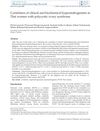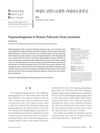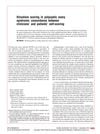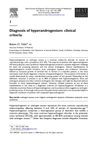Approach to the Patient: Hirsutism
April 2025
in “
The Journal of Clinical Endocrinology & Metabolism
”
TLDR Hirsutism affects many women and is managed with a combination of medical treatments and hair removal, tailored to individual needs.
Hirsutism affects about 10% of women worldwide, significantly impacting their quality of life and finances. It is characterized by male-pattern hair growth due to factors like circulating androgens and various enzymes. The modified Ferriman Gallwey (mFG) scale is used to assess hirsutism, with scores above 4-6 indicating its presence, though this can vary by ethnicity. Hirsutism is often linked to polycystic ovary syndrome (80-90% of cases), idiopathic causes (5-10%), and non-classic adrenal hyperplasia (1-10%). Less common causes include androgen-secreting tumors and other medical conditions. Treatment depends on symptom severity, reproductive goals, and underlying causes, with options including medical therapies and hair removal methods. Effective management typically combines these approaches, emphasizing shared decision-making between patient and clinician.




